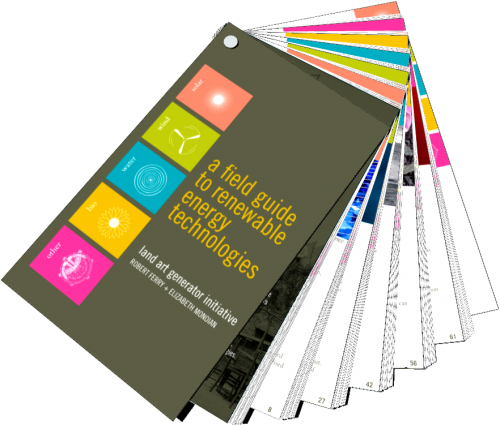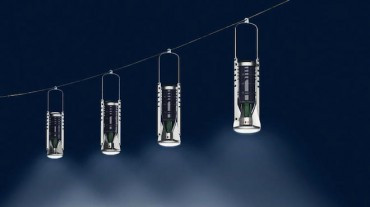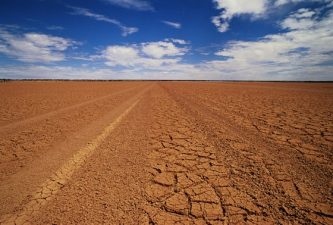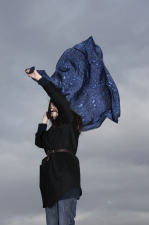 Dubai-based couple develop proven green technologies guide for like-minded architects.
Dubai-based couple develop proven green technologies guide for like-minded architects.
There are more than 60 proven ways to harvest nature’s power and convert it into clean, renewable energy, but knowing where to find information about these various applications isn’t always so easy. Enter Robert Ferry and Elizabeth Monoian from the Land Art Generator Initiative.
The Dubai-based design duo have listed dozens of established technologies that harvest solar, wind, water, and bio energy, in one easy-to-read guide. With one accessible but thorough listing per page, the LAGI field guide is bound to become the clean tech bible for all architects, designers, journalists, students, and urban planners, as well as anyone else interested in sustainable technology.
Damless hydro and other hydroelectricity
The LAGI guide introduces technologies that we didn’t know existed. For example, it turns out there are four different ways to produce hydroelectricity from rivers, with dammed reservoirs being just one of them. Other methods include Damless Hydro, Mico + Pico Hydro, as well as Vortex Hydro.
Solar energy is no longer limited to the standard photovoltaic panels or thermal solar panels. There are 23 proven solar technologies listed in the LAGI guide, along with their benefits, their derivatives, and their efficiency levels.
Ferry and Monoian have carefully researched each technology listed but provide only the bare minimum necessary for readers to make informed choices about which products are best suited to their particular projects.
Science for the scientifically challenged
About photovoltaics made with silicon, Ferry and Monoian write:
Silicon is the most common metalloid found in nature. It is typically found as silica (SiO2) in sands rather than in its pure elemental form. Silicon makes up 27.7% of the earth’s crust by mass. Molten salt electrolysis can create pure silicon from silica with low energy input and no CO2 emissions. More commonly, high temperature furnaces (1,900°C) create the condition in which silica is converted via reaction with carbon into pure silicon. SiO2 + 2 C -> Si + 2 CO
This important information is carefully followed up with practical details that are useful for even the most scientifically-challenged readers:
Silicon (Si) is a semiconductor material that displays the photovoltaic effect. It was the first material to be employed in solar cells and is still the most prevalent. It can be applied for use in either a crystalline (wafer) form, or in a non-crystalline (amorphous) form.
And then they cut to the chase:
There are two types of crystalline silicon (c-Si): monocrystalline and polycrystalline (aka multicrystalline).
Monocrystalline is expensive to manufacture (because it requires cutting slices from cylindrical ingots of silicon crystals that are grown with the Czochralski process) but it is the most efficient crystalline silicon technology in terms of energy conversion.
Polycrystalline is easier to manufacture and can be cut into square shaped slices, but has slightly lower efficiency (approximately -5%). It is comprised of small crystals or crystallites.
LAGI 2012 and High School kids
Destined to be the design world’s new bible, the LAGI guide easy and free to download – thanks to generous supporters of the Land Art Generator Initiative and Society for Cultural Exchange – and it is timely.
The 2012 LAGI site-specific design competition for Freshkills Park in NYC – the world’s largest landfill that will be 3 times as large as Central Park – is underway, and this year even young designers are invited to submit their proposals.
According to Monoian, the High School brief was written “as more of a narrative,” and many of the most technical language has been removed. “But at its heart it is asking for the same thing.”
Students who participate in the LAGI High School Edition will learn about model building and sketching as well as “what it means to consider the environmental impact,” Monoian explained to Green Prophet in an email.
Everybody’s renewable energy bible
“The LAGI team and 2012 partners (Society for Cultural Exchange, NYC Department of Parks & Recreation, COAHSI, and the Institute for Urban Design) will act as the jurors for the High School edition, following the five judging criteria,” says Monoian. But if this year’s experiment is successful, then she and her husband hope to create a more formal juror panel in future competitions.
As is often the case with the LAGI team, their guide is accessible to anyone. Created not as an exclusive resource for design professionals, instead the field guide is expected to raise public awareness and acceptance of renewable energy technologies so that we – you, me, and the hairdresser down the street – can collectively blaze a path to a “truly sustainable world.”
:: Land Art Generator Initiative
More on LAGI, Renewable Energy, and Other Beautiful Things:
Breaking! Ground Zero Rubble Site to be Adorned by Dubai-Based Design Team
Interview With Dubai’s Most Innovative Design Couple
Energy-Generating Pyramids Win Abu Dhabi’s LAGI Prize
Comments
4 thoughts on “Free, Easy-to-Use Field Guide Lists 60 + Proven Clean Energy Technologies”
Comments are closed.




Very nice! Very, very important!!! Will pass this on, and hope it will become viral!
I’m glad you like it Aviva.
Hi Karin,
There are a lot of great RE innovations coming from Israel.
In fact, just the other day we posted a feature blog article about Aora:
http://www.landartgenerator.org/blagi/archives/1899
We will continue to raise awareness about all RE technology, especially as it relates to its aesthetic manifestation in the constructed environment, regardless of where it comes from.
After all, in the world of ideas there are no boundaries! 🙂
I wonder if this organization dared to include any technologies or clean tech innovation from Israel.